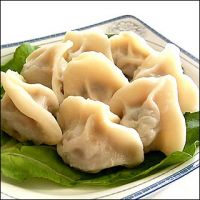Dumplings
Jiaozi or dumplings, (boiled dumplings stuffed with meat and vegetable filling) are also known as gengnian jiaozi (seeing in the new year dumplings). Although boiled dumplings have been a favorite food of the Chinese people for thousands of years, they have only been essential element of the lunar New Year's festivities since the Ming Dynasty. Jiaozi are the exact size and shape of the small gold ingots that were used for money in ancient China, so eating jiaozi satisfies the desire for wealth. Of course, jiaozi are also incomparably delicious, so on New Year's Eve, virtually everyone in China can be found eating this holiday dish. When vendors boil jiaozi to sell, they will often deliberately break one or two in the pot. But they do not remark upon this with taboo words, such as "break," "shatter," or "disintegrate." Rather, they say that the dumpling's filling has "burst," which in Chinese is a homonym for the auspicious phrase "to get rich."
There are many different regional customs concerning eating jiaozi to celebrate the lunar New Year. In some places, they are eaten on the last day of the year, and called tuanyuan jiaozi (reunion dumplings); in others they are eaten on New Year's Day and called nianfan (first meal of the new year). People in some regions traditionally eat jiaozi on the fifth day of the New Year. This day is known as Powu (Broken Fifth), so they are called powu jiaozi (Broken Fifth dumplings). And in some places, people eat jiaozi late into New Year's Eve and continue throughout New Year's Day, symbolizing continuing abundance from year to year. But the most common practice is staying up late on New Year's Eve wrapping, boiling, and eating dumplings to mark the transition between the old and new years. These jiaozi are called gengnian jiaozi (seeing in the New Year dumplings), signifying that the New Year will bring good luck and abundance.
On New Year's Eve, the house is brightly lit as the whole family stays up all night to see out the old year and see in the new. People do more than just sit around as they wait for the arrival of the New Year. There is plenty to eat and drink, including wine, cooked dishes, New Year's cake, boiled dumplings, fruit, and assorted snacks, and all kinds of games are played. Since it's nighttime, most of the games are played indoors. Popular games include Go, Chinese chess, card games, and mahjong. Before it gets dark, children ride bamboo horses, spin tops, and play games like "Eagle Catches Chicken" and "Blind Man's Bluff." As midnight approaches, the parents prepare the family altar. They then light incense and make offerings to the ancestors and auspicious deities, bringing the New Year's festivities to their peak. After the ceremony is over, everyone exchanges New Year's greetings and eats boiled dumplings. It is also traditional to set off fireworks and firecrackers on New Year's Eve. As it gets closer and closer to midnight, nonstop explosions fills the air and the sky is filled with a sparkling display.
Since the 1980s, it has become extremely popular to watch the annual "Spring Festival Gala Show" on television on New Year's Eve.
